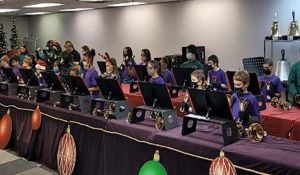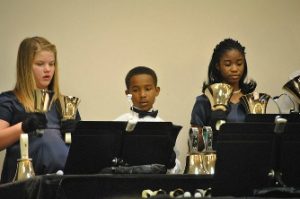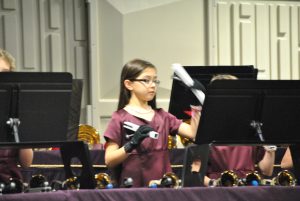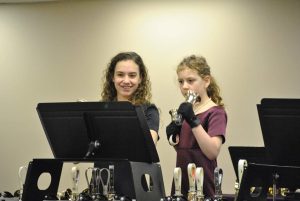Bells After School – a new way to look at handbells for kids!
by Neesa Hart, Programming Director of the Stafford Regional Handbell Society

My advanced youth ensemble had their concert recently, and I happened to arrive at our rehearsal/performance studio just as the After School Bells program director was moving the students from our downstairs area to our upstairs area. I was so gratified to watch the parade of 1st – 8th graders marching by as they headed to the new rehearsal zone. Represented in that group was such cultural, racial and demographic diversity, it was like watching a little micro video of why a program like this is so revolutionary.
First, a little background. About 10 years ago, I was sitting at a traffic light, and I found myself surrounded by 15 passenger vans from martial arts studios. They all had branding on the side announcing ‘After School Programming.’ I had heard, previously that our county considers that to be a core need. We are a heavily commuter-based community. There is a critical shortage of childcare for school-aged children before and after school.
It occurred to me that there are 16,000 elementary students in our county. Surely, not all them want to go to Karate every day. I went home and did a somewhat comprehensive search. I found that only three types of after school care were offered here. Your child could choose from one of several Martial Arts programs; our preschools – like Children of America and MiniLand – offer pickup and transport to their preschool facilities; and our YMCA offers a limited program in the schools where families who qualify, based on need, can drop their kids at school early and pick them up late. This program is always oversold and entails a couple of college age students supervising the kids in the cafeteria, or gym, where the kids are expected to sit and do homework until they are picked up.
 I felt like there MUST be space for another option. Surely, 30 out of 16,000 students would like, and benefit, from a music-based program. We were blessed to own 15 passenger vans that we used for a tour project, so we printed some yard signs saying “we pick up,” opened enrollment and planned on 10-12 kids coming daily to learn bells.
I felt like there MUST be space for another option. Surely, 30 out of 16,000 students would like, and benefit, from a music-based program. We were blessed to own 15 passenger vans that we used for a tour project, so we printed some yard signs saying “we pick up,” opened enrollment and planned on 10-12 kids coming daily to learn bells.
Well. The best laid plans and all that. What I did not count on was not having each child every day. In my mind, Mrs. Edwards would need Monday through Friday care for her child, and she would send him every day. What I learned, was that Billy needed to come on Mondays and Thursdays. Emily came 5 days a week. Tamika came on Tuesdays and Wednesdays, and Evan’s schedule changed on a week to week basis.
So, how in the world were we going to rehearse? Before Bells After School, we taught children’s bells the same way everyone else does – the same way I learned. We put kids behind tables, put bells in their hands and taught them to ring. They would perform a concert at the end of each semester – or in the church model, periodically in a worship service – and the ‘push’ was always to get the repertoire prepared. Don’t get me wrong. This method is tried and true, has worked for years, and has its place in our pedagogical universe.
BUT – it just was not going to work in the after-school setting. So, on the plus side, we had 15 kids coming to us and PAYING a weekly fee to learn to play bells. There is a paradigm shift! The program has now expanded to 50 kids. On the not-so-plus side – the traditional instructional model wasn’t going to work. Time to pivot. What we developed was a curriculum that is graduated – similar to martial arts. Children receive guide books when they enroll with specific skills that allow them to ‘level up’ when mastered.
This is easiest to explain if I walk you through the process.
 Kemoni enters the program as a 2nd grader with no musical knowledge. She is a RINGTONE. We have multiple Ringtone ensembles for beginners. The Ringtone Shakes (younger children who don’t come more than 2 -3 times per week – so they are ‘shakey.’) The Ringtone Gyros – kids who come more than 3 times per week and are a little older – so they reasonably advance more quickly. Ringtone Echoes – oldest students who are going to advance quickly enough to complete the Ringtone curriculum before the end of the semester. This system requires some evaluation meetings and some flexibility, but it has the advantage of putting kids into groups where their skill levels are not so diverse that advancing ringers get bored and struggling ringers become frustrated. Each group is assigned a set of repertoire – maybe 3-4 pieces – that is level appropriate.
Kemoni enters the program as a 2nd grader with no musical knowledge. She is a RINGTONE. We have multiple Ringtone ensembles for beginners. The Ringtone Shakes (younger children who don’t come more than 2 -3 times per week – so they are ‘shakey.’) The Ringtone Gyros – kids who come more than 3 times per week and are a little older – so they reasonably advance more quickly. Ringtone Echoes – oldest students who are going to advance quickly enough to complete the Ringtone curriculum before the end of the semester. This system requires some evaluation meetings and some flexibility, but it has the advantage of putting kids into groups where their skill levels are not so diverse that advancing ringers get bored and struggling ringers become frustrated. Each group is assigned a set of repertoire – maybe 3-4 pieces – that is level appropriate.
So, back to Kemoni. She comes 4 days per week after school, so she is a Ringtone Gyro. Like all Ringtones, she receives a purple martial arts style ‘belt,’ a Ringtones achievement book, and a Ringtones t-shirt when she enrolls. On the days she attends, her instructor may do a variety of things during instruction time. On some days, they will rehearse repertoire. On some days, they will do a group activity and play games that emphasize musical skills (Ask us about “The Road to Belldorado”) Other days are spent working with students to master skills in their books. There are specific skills in the achievement guides. Each level has the following mandatory steps for advancement:
- The Musical Roadmap – Music reading skill
- Rhythm Mastery – Rhythm patterns
- Handbell Notation
- Handbell Ringing Mastery – students have to demonstrate mastery of various techniques including those in the notation section.
- A rhythm mastery test
- A level mastery test – this incorporates all the skills in the book and must be passed before a student earns their next level belt.
Once Kemoni passes her mastery test, she moves on to Bellistic and receives her red belt. Her repertoire is more complex, and the advancement criteria is more difficult.
 When we deployed this advancement curriculum, it helped solve the problem of varied attendance. First, instructors/directors, were able to rehearse repertoire with whole or partial groups depending on attendance. Whole ensemble attendance is REQUIRED for 2 days per week during the 3 weeks prior to the concert date. It also allowed the instructor to rehearse repertoire with smaller than a whole group by using the skills students were learning to look at specific parts of the music. In Handbell culture, we have events where we ask ringers to prepare repertoire ahead of time – on their own. Then, everything is pulled together as an ensemble in a series of focused rehearsals. This curriculum works the same way.
When we deployed this advancement curriculum, it helped solve the problem of varied attendance. First, instructors/directors, were able to rehearse repertoire with whole or partial groups depending on attendance. Whole ensemble attendance is REQUIRED for 2 days per week during the 3 weeks prior to the concert date. It also allowed the instructor to rehearse repertoire with smaller than a whole group by using the skills students were learning to look at specific parts of the music. In Handbell culture, we have events where we ask ringers to prepare repertoire ahead of time – on their own. Then, everything is pulled together as an ensemble in a series of focused rehearsals. This curriculum works the same way.
There was, however, a second, unexpected result. We discovered that we were educating better musicians. Previously, we had a group of kids who knew how to play 4 or 5 songs. OF COURSE, they had learned some technique and some rhythm skills in the process of learning those songs. BUT, when the new semester started, there was always an apparent learning-lag. Some students seemed to barely retain what had been worked on in previous seasons, while others were advancing.
With this curriculum, students master skills before they move to a new level. It is admittedly a little tricky when it comes concert time because I may only have 4 students who are OVERTONES – the third level book. So, what repertoire are these Blue Belt ringers going to perform? There are different options for this. Typically, we just recruit advanced students to fill in the gaps, but, certainly, we could find 8 bell music and make sure we are incorporating the techniques required at this level of ringing. Quartet music is also an option, though it may require additional bells and not everyone has them.
 The ’less than a whole ensemble’ challenge can be a lot to overcome, but we have been successful recruiting either adult ringers who will perform in the concert, or, we use advanced student ringers. We REQUIRE that every ringer who moves beyond the RINGTONES level be available to perform, on demand, with lower groups as Master Ringers.
The ’less than a whole ensemble’ challenge can be a lot to overcome, but we have been successful recruiting either adult ringers who will perform in the concert, or, we use advanced student ringers. We REQUIRE that every ringer who moves beyond the RINGTONES level be available to perform, on demand, with lower groups as Master Ringers.
So, Kemoni is fairly advanced and motivated. She zips through the Ringtones curriculum and earns her red Bellistic belt by mid semester. She earns the right to wear the Bellistic attire at the concert, but she remains with her assigned Ringtones ensemble for the balance of the term. She is recognized as a “Master Ringer” at the concert. When the next semester begins, she moves into Bellistic and begins working on their repertoire.
We color-brand each ensemble, which helps with both recognition and teamwork. As students move through the curriculum, and complete the required skills in each area, they earn virtual ‘badges.’ We recognize this with a running slide show in the lobby that recognizes each student individually and emphasizes their achievement. They earn belts by completing mastery tests for each level. We recognize these achievements at the semester-end concert.
This process helps Kemoni remain motivated in several ways. She is in control of her own achievement level. She can advance as quickly, or as slowly as she needs or wants to. Her success is measurable and recognizable. Her parent(s) can clearly see the fruits of what she is learning – daily when they pick her up and see the slide show, and at the concert when we recognize students who have advanced. Kemoni is becoming a strong musician and is developing a love for ringing handbells.
Win. Win.
While we had the advantage of being able to transport kids to our space, this model would certainly work in an individual school. Many school districts offer after school programming and an After School Bell program would fit nicely into the existing structure in locations that have space available.
Certainly, you could modify the program. Certainly, you could use chimes instead of bells. Certainly, you could scale up or down to meet your own needs.
I really want to encourage, you, though, to think about how an after school or before school program could grow your children and youth ringing program and, even better, expand the reach of handbell ringing into your community.
 This is a great opportunity to put an unused set of bells to use. There is a story about Oliver Cromwell during England’s reformation period. The government was running out of money. Taxes were already too high. His advisors came to him and said, “there isn’t anymore gold to be had. The only gold left in the Commonwealth is the statues of the saints in the churches.” To which Cromwell responded, “the let’s melt down the saints and put them into circulation.” Unused bells are accomplishing nothing. They are dishonoring the people who sacrificially gave funds to purchase those bells. They are falling into disrepair. And no one is learning to love ringing by looking at four cases on the floor of a church closet.
This is a great opportunity to put an unused set of bells to use. There is a story about Oliver Cromwell during England’s reformation period. The government was running out of money. Taxes were already too high. His advisors came to him and said, “there isn’t anymore gold to be had. The only gold left in the Commonwealth is the statues of the saints in the churches.” To which Cromwell responded, “the let’s melt down the saints and put them into circulation.” Unused bells are accomplishing nothing. They are dishonoring the people who sacrificially gave funds to purchase those bells. They are falling into disrepair. And no one is learning to love ringing by looking at four cases on the floor of a church closet.
It is time for creative solutions. Can you borrow a set of bells from a church that isn’t suing them? Can you get grant funding to purchase a set of chimes? Area 3 offers loaner chime sets for programs just like this. Can you do a community fundraiser? Can you get corporate sponsorships? Is there any funding available at the school level. Does a school in your district already have a set of bells that could be used.
Can you fit a program like this into an existing after school environment? Does your church have a licensed preschool – then, PRO TIP – parents of elementary aged children can receive child-care reimbursement from the state to send them to your program.
As I watched that group of 50 kids walk by me, and listened to them interacting with each other, building team-based relationships, integrating with each other through a shared joy of ringing, I saw a bright future for our instrument. Many of these kids would never reasonably have access to music education – a $6000 flute would be out of the question for most of these families – but in bells, everyone succeeds together. There is no distinction between students based on their family’s ability to afford private lessons and expensive instruments.
If you have a love of ringing, and you have a love of kids, I would strongly encourage you to consider some type of after school program. If you need help, PLEASE feel free to reach out to me for resources, ideas, and suggestions on specific problem solving.
As we say here in Stafford – “Grab your Bells and Get out There!”
